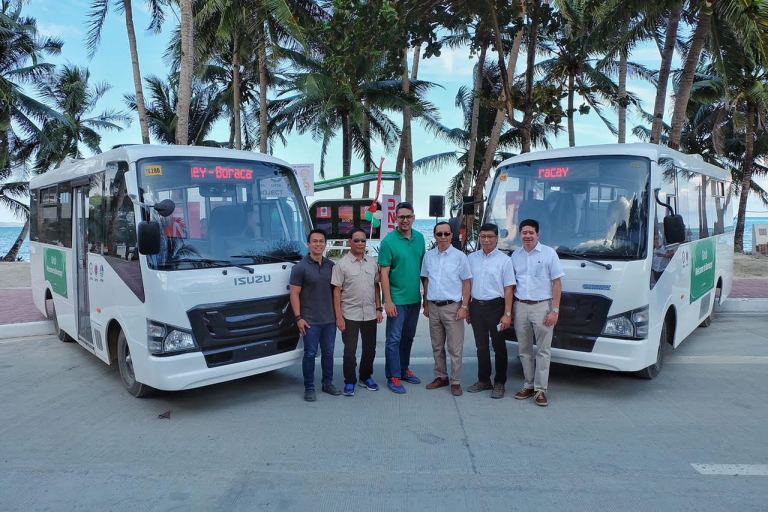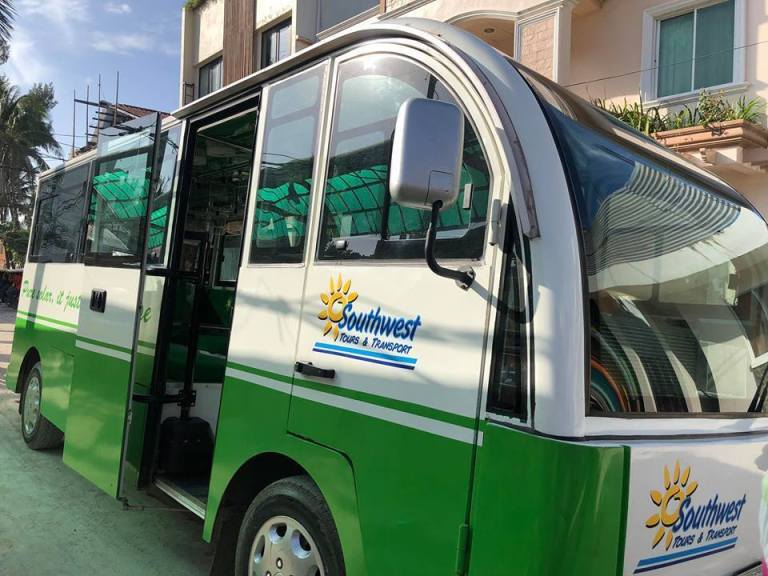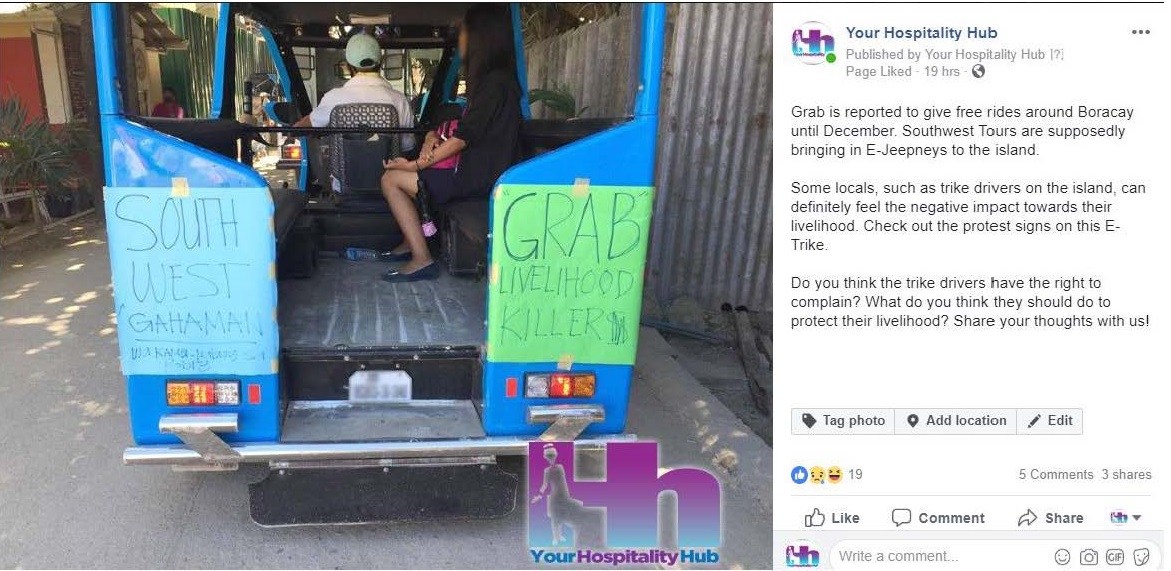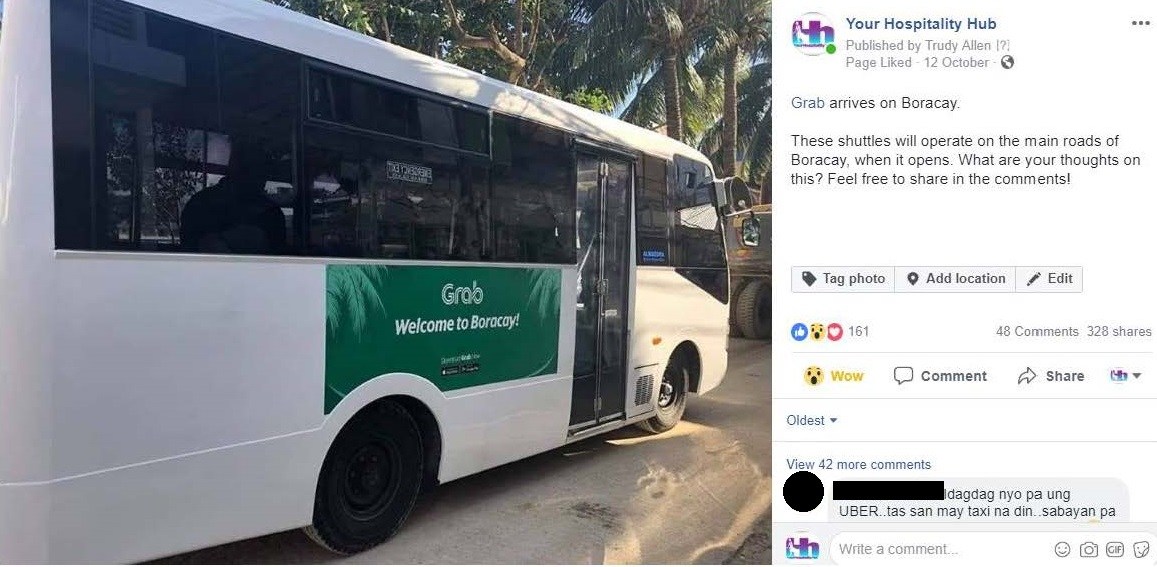What Boracay’s Trike Drivers want you to know
During the last two weeks of Boracay’s closure, Your Hospitality Hub/RANGGO Magazine launched two photos on their Facebook page for comments. One showed the new Grab buses, which will operate around the island. The other showed a handwritten protest, taped to the back of a Boracay trike against Grab and the new SouthWest Travel and Tour owned solar buses.
Both posts got a lot of reactions and we, of course, expected negative and positive comments. It didn’t surprise us that a lot of residents and islanders of Boracay made comments such as ‘good’; as surely steps towards better eco-friendly transportation is always a good thing. However some of the comments on the post, other Boracay Online Forums and overheard locally, did give us pause to reflect:-
“Finally!!! Let them feel it now”
“Serves them right, for being greedy”
when the Closure of Boracay was announced and the blame was laid by Mainstream Media, at the door of the “Greedy Hotel Businesses”. Many people reacted with similar comments on articles and online posts:
“serves them right, they’ve made their money, let them go without now”
“six months is nothing, they are rich from the island; the closure is their fault
Many islanders reacted in support of the hotels, pointing out that not all were violators and that many had loved, and moved to, Boracay to make it their home.
Should the same consideration be given to Boracay Trike Drivers and Operators?
Not all try to overcharge, or refuse to take passengers to their requested destination, as cited by islanders. There are very many Boracay Trike drivers and operators, who have tirelessly driven the roads of Boracay. Who have followed the agreed Fare Rates. Who do stop to pick up school children. Who have remained friendly and professional. But modern human nature seems to favor our remembering the ‘bad’ drivers over the good.
Is it fair to tar all Boracay Trike drivers with the same brush?
What is the current situation for Boracay Trike Drivers?
Your Hospitality Hub was contacted by a Boracay Trike Operator after the protest photo was first posted. The Operator wanted to explain their situation, in the hopes that the same community support, given to the hotels and resorts, will be extended to the Trike community.
Your Hospitality Hub met with representatives on Saturday 27th October, one day after Boracay re-opened. We agreed to present what they had to say anonymously. The biggest concerns to the Boracay trike community:-
- The lack of any consultation by the Department of Transport (DOTr) and Land Transportation Franchising and Regulatory Board (LTFRB) with Boracay Trike Drivers, Operators, BLTMPC and even Malay LGU
- The appearance according to one article [1.] of a Boracay Land Transport Group (BLTG) that trike franchise holders are not aware of, and have not been invited to be part of.
- That the normal processes drivers or operators have to go through to be allowed to operate, and hold ‘franchises’ appear not to have been applied to Grab
- That a large contract was discussed seemingly without any apparent research in to impacts on island traffic, or the impacts on the current transport owners and drivers livelihoods; Boracay has just over 20km of road, 50 buses on the island would therefore average one Grab bus every 250 meters.
- That the Grab buses will be free until December 2018, which the local trike providers can not match. And may offer discounted fares to residents after December. Such offers potentially reduce the numbers of passengers using e-trikes for a further 2 months.
- Boracay trike drivers had been relying on full operations from 26th October, after a hard 6 months of closure.
- That many drivers and operators have taken on 3 or 5 year loans to purchase e-trikes, with a massive chunk of their daily profit lost to loan repayments and expensive part replacements and maintenance due to the current state of Boracay’s roads.
- At the start of the closure there were plans to reduce vehicles on the island and now significantly larger vehicles are coming in, which will still impact on traffic as the ‘bus stops’ are not set back from the road.
- That the receiving drivers of the “donated” e-trikes will still have to pay the procurement cost of their new vehicles, by installments. It is not in these driver’s interests to be saddled with paying for new E-trikes if competition from buses will make it impossible to cover loan repayments and operating costs.
- That whilst Boracay Trike Drivers and Operators were required to upgrade to e-trikes, to protect the environment, Grab will be operating vehicles that are run on Diesel, even if the units do utilize ‘blue technology’
“Had we known that Grab would be bringing these buses in, many of us wouldn’t have taken on loans to buy new e-trikes! You tell people they must change their vehicles to e-trikes to operate, and then you introduce a new element, which stops people from being able to pay their commitment (loan), without warning!”
What are the proposals which Boracay Trike Drivers and Operators believe will crush their livelihoods?
Grab: The Isuzu Philippines Corporation (IPC) turned over 4 modern Public Utililty Vehicles (PUV) to the Boracay Land Transport Group (BLTG), with the help of the Department of Transportation (DOTr), Land Transportation Franchising and Regulatory Board (LTFRB) and Grab Philippines. The PUV’s were delivered to Boracay on October 26, 2018 [1.].

The PUV’s are Class II QKR77, made by Almazora, each with a Euro IV-compliant 3.0-liter turbo-diesel which utilizes BluePower technology. Each PUV has the capacity to seat 22 passengers, as well as additional standing passengers. CCTV, hand rails and LCD screens are all features. Autoindustriya.com [1.] reports that eventually there could be up to 60 PUV’s operating on Boracay’s Circumferential Road, with 16 “Bus Stops”.
Various media outlets have reported that the fare will be 300-350PHP for unlimited travel, over 3 days. Tourists will be able to top-up their Bracelets or Cards should they be staying on Boracay longer than 3 days. Manila Bulletin advised that there will also be discounted passes available for locals and concessionaires [5.].
“Aircon buses seem nice, but not if it puts hundreds of local e-trike families out of business”.
“who is financing this, that’s what we want to know? Who actually owns these buses? Where has the money come from for 40 or 50 Buses? No-one has told us anything”
“I thought the islands rehabilitation was about supporting the small local island businesses. But all these contracts going to big outside players”
Initially it was feared by Boracay Trike Drivers that SouthWest Travel and Tours Boracay, would also be offering a similar service to Grab. Your Hospitality Hub has been advised by SouthWest Travel and Tours, that their new Solar Buses and e-jeeps serve purely to upgrade their own Airport Transfers fleet due to the requirements being enforced by the LTO (Local Transport Office).

A representative confirmed that their vehicles will continue to serve tourists who have booked Airport Transfers with them. They do expect to serve some Boracay Resorts, whose vehicle capacity has been reduced to just two units. And once the roads around the island have been completed SouthWest Travel and Tours will resume the hire of their vehicles for island tours, which was also a staple service prior to the closure. Hiring e-trikes for an Island Tour is also available.
Operation requirements for Boracay Trikes:
- Existing e-trikes operate on Boracay with a Local Government Unit (LGU) issued “franchise”; this is for the trike not the driver/owner, and covers tax as well as controls the number of vehicles.
- The franchise must also be registered with the Land Transportation Office (LTO), as per national requirements.
- There is believed to be a cap of 700 franchises currently existing for Boracay, derived originally from petrol-fueled tricycle operations.
- Motor tricycles used to operate on a day-on-day-off “coding” system, so it wasn’t that all 700 franchises operated daily.
- As of May 2018 approximately 275 e-trikes were operating on Boracay, with no day-on-day off “coding” system in place for them.
- A Government resolution was issued 3 years ago, permitting the sale and transfer of existing Boracay tricycle franchises. This allowed new owners to take over an existing franchise, as no additional franchises were being released by the LGU. The Sale and Transfer was allowed only on the condition that the new owners invested in e-trikes.
- Restrictions still apply to e-trike franchise ownership, with a limit to the number of franchises issued per person, who must be Filipino; foreigners can not own trike franchises.
Costs of Boracay Trikes
- E-Trike costs range from P500,000 to P700,000; the cost of a new car. The old fuel-powered units cost P100,000 to buy and were cheaper to repair and maintain. No matter the price a Unit, the fare remains P10 a Station for passengers.
- Franchise holders and e-trike owners have to earn at least P700 a day, just to cover the loan commitment per e-trike. Their loan commitment is either 3 or 5 years depending on the e-trike model.
- During the closure some e-trike drivers earned as little as P200, not even covering the loan commitment, let alone earning them money to live on.
- The very first e-trike owners faced substantial additional costs due to mechanical issues with the earlier models, particularly the transmission and brake systems. At least one e-trike supplier changed hands and owners faced substantially increased prices for maintenance and repairs under the new management. Parts are often specific to each e-trike model and the cost of these essential safety improvements were born by those operators who led the way towards electrification of the Boracay trike fleet.
- During the closure we have been advised that at least one e-trike supplier had to withdraw their vehicles from service, due to the condition of the roads. Operation by another e-trike supplier became uneconomical due to the cost of the battery exchange system, due to reduced passenger numbers. There may have been more drivers or operators who had to remove their e-trikes from operation.
- If the day-on-day-off “coding” system is introduced for e-trikes, to limit vehicles on the road, then the repayment of loans will not be economically achievable for those that have them.
Summary
- Owners and drivers committed to the new transport plans of the LGU for green transportation, investing in expensive e-trike Units, which they will be paying off over the next 3-5 years.
- During the closure at least two operators had to stop running their e-trikes entirely due to costly repairs or because they couldn’t meet the daily loan amount or the running costs of an e-trike, with fewer passengers
- E-trike owners and drivers have tried to manage their personal budgets to get them through 6 months of closure, not always successfully. With 4 large buses giving free rides, they now face another 2 months of reduced income and ability to pay off their loans
- E-trikes support local Boracay families, who in turn spend the money locally in businesses belonging to other Boracay families.
- Grab buses will employ far fewer drivers, and most profits may well go outside of the community of Boracay.
- Grab may be offering ‘Franchises’ for the next lot of Buses to arrive, when trike operators understood there was a cap on ‘franchises’. This information was provided to us by Autoindustriya [1.] A request for clarification was sent to the DOTr but we are yet to receive a response.
For Boracay’s residents there remains the argument, since the re-opening, of unscrupulous drivers charging astronomical fares for private journey’s; sometimes double or triple the amount that used to be charged for the same distance. Or refusing to stop for, and pick up, school children.
Often this is reported as drivers of the old trikes, which are being fazed out. The response to this is for people to photograph the drivers shirt, with their ID and report it to BLTMPC. BLTMPC will call the driver in to explain themselves and they may find themselves suspended from operating for up to 15 days. Operators advise that if the driver doesn’t attend, then they are called in and will suspend the driver themselves.
Other complaints from Boracay residents are that they are turned down for a journey because it is “too far”. In some cases this is true; the e-trike doesn’t have enough remaining charge to make the journey and get back to a charging station, but the driver doesn’t explain this.
Another comment is that the Operators, who may own several trikes and employ drivers or rent the trikes to drivers, taking a daily fee for the hire, have done quite nicely and have expensive homes or property. Surely a counterargument would be that there are a very many people on Boracay, who have been able to buy or build their own home because of their business acumen. Why should this be a ‘black mark’ against Trike Operators, when it isn’t one against hotel, restaurant or bar owners?
“SB and LTO encouraged locals to invest in etrikes. It would be unfair if the viability of those operations are now undermined by a diesel bus service, which to date does not appear to have the legal franchise to take paying passengers.
Hopefully LTO will uphold their duty towards managing all PUVs on the island in accordance with the existing laws.
There appear to be conflicts of interest between the various parties, however there is hope that some measure of sensible governance will prevail. Balanced coverage, including the depths of the issues, is sorely lacking”.
Certainly, if there is a shortfall in environmentally friendly transport services, this needs to be addressed. But consideration must be given to existing residents of Boracay who have already invested in the solution, ahead of Grab’s arrival.
** Your Hospitality Hub also sought to speak to a representative of Grab Philippines but we were unable to secure a contact number or an email address, from any avenue, to ask for a response from them.
Article Sources:
- You can now hitch a ride with Isuzu’s modern PUVs in Boracay – AUTOINDUSTRIYA.com
- LOOK: E-trike, modern vehicles for the ‘new’ Boracay – Rappler
- Isuzu turns over modernized PUV units to Grab in Boracay – Business Mirror
- E- BUSES FOR BORACAY – DENR website
- New Boracay transport system ready for island’s reopening – Manila Bulletin
- Two ride-sharing apps get the LTFRB’s stamp of approval: Say hello to Hype and HirNa – Top Gear Philippines
- How much are the fares of new ride-hailing apps? – Rappler







GIPHY App Key not set. Please check settings